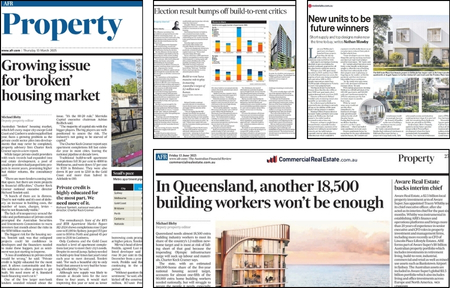As featured in The Urban Developer
23 September 2025
First comes the bulge and then comes the hangover.
But we’re not talking about a night out in Fortitude Valley.
South-East Queensland’s property market is severely distorted and at risk of dislocation without serious changes, warns Charter Keck Cramer national executive director Richard Temlett.
The bulge he refers to is the huge pipeline of work associated with the 2032 Brisbane Olympics and the challenge the region’s construction sector will face to digest the extra work.
Temlett says the industry is already stretched in South-East Queensland with too few builders to tackle the growing workload.
Building capacity a handbrake on development
Productivity is a major challenge on worksites across Brisbane and the Gold Coast, with construction heavyweights citing productivity at 2.5 days a week.
Developers are also looking to the horizon and how they can work around the impending bulge. Timing will be crucial.
“You’ve got very strong revenue growth, but you’ve also got strong building and cost growth,” Temlett says.
“The market still works, but you’re getting bizarre results. It’s distorted. It’s not behaving like it would in a normal balanced market.”
Sentiment remains positive and pricing is pushing ever upwards, but the south-east corner could be in for a fall. Particularly in the years following the Olympics, which are often described as an afterglow, but could be more of a hangover, Temlett says.
“People don’t really talk about it, but in the lead-up to the Sydney Olympics in New South Wales, lots of infrastructure was delivered, prices jumped ... and then there was almost like a bit of a depression,” Temlett says.
“It is probably a bit of a harsh word, but the market pulled back after 2000. I suspect the same thing is going to happen in Brisbane.
“There is even more risk when you think about that because you have got an extremely strong market with hard deadlines in terms of getting infrastructure done, significant events that really put Brisbane on the map, and then suddenly all of that activity just moves away or slows down.”
While Temlett doesn’t believe Brisbane will “fall off a cliff”; he is worried about one hell of a hangover that is looming over the River City.
Interest rate cuts have caused the Queensland economy to accelerate and contributed to increasing revenues and building costs.
The city’s apartment supply is low and forecast to remain undersupplied for the remainder of the decade, despite strong demand and deep pockets.
2028: Year of the Bulge
Temlett says the rubber is likely to hit the road between 2028 and 2032 with a chronic shortage of building capacity, which will likely mean non-Olympic projects will either need to be completed ahead of 2028, or wait until beyond 2032.
But the cost of building in the Sunshine State is also becoming a key challenge. Temlett says pricing is close to 50 per cent higher in Brisbane than it is in Melbourne, which he says underscores the level of risk in the SEQ market.
“I think modular and prefab is one of the solutions, but it’s not going to be the only solution,” Temlett says.
“There’s productivity gains, and better quality design ... it’s one solution that the Government really should consider. But productivity in Queensland is the worst.
“The industry is actually ripe for disruption. The Government does need to look at the legislation, both the building and the planning legislation.”
It’s an over-regulated industry that needs deregulation, Temlett says.
“It leads to more costs and delays, which ultimately just gets transferred to the end buyer,” he says.
Temlett says that nationally, there are four key areas that require reform: planning, tax, labour and immigration.
Reform needed to free up market
Temlett believes taxation reform will be key to making projects feasible.
“When you look at the costs of taxes on some of these properties, they make up 30 to 40 per cent of the actual cost,” he says.
“A proper tax system ... should be promoting fairness and equality. They should not be anti-competitive, which is what they are [currently].
“Stamp duty, that’s just a killer.”
According to Charter Keck Cramer’s data, Brisbane apartment launches were at 52 per cent of the 10-year average, while apartment construction starts were down at 32 per cent.
Brisbane is expected to turn out an average of 1500 apartments a year in the next three years, well below housing targets.
It’s a different story on the Gold Coast, however, where a forecast 2300 apartments will be completed each year in the next three years, almost twice the historical average.
Temlett says that the next property cycle has already begun, and headwinds have now turned to tailwinds for the sector.
The key challenge will be ensuring a depth of building capacity to manage the Olympic-sized bulge in South-East Queensland.



